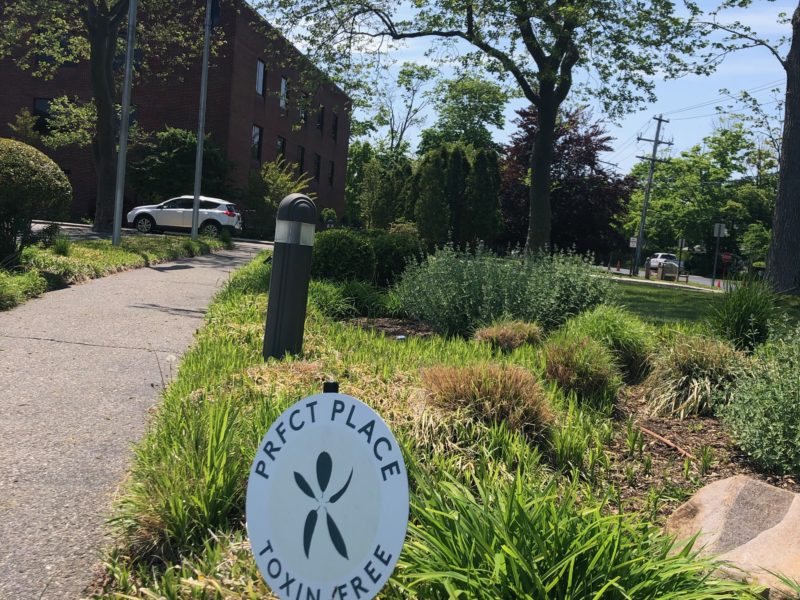

“Our customers can’t get away from us by simply dying”
— Charles Mills, president of The Scotts Company, 1948
Through a series of bad career choices, I once found myself sitting in a conference room with the marketing people from Scotts LawnService, being briefed on how to market their “winter fertilizer.” I wondered out loud why people would use fertilizer in the winter when lawns were dead. “I mean, isn’t that like selling night-time sunscreen?” I asked. It didn’t make any sense.
Welcome to the modern American lawn, whose AstroTurf green comes straight from the glory days of 1950s suburban sprawl and Levittown conformity.
Today we’re paying a high price for this outdated notion of perfection. In the quest to make lawns look like Augusta National, one can forget that yards are part of the ecosystem. Pouring toxic weed killers and pesticides on them is wreaking havoc on our bees, birds, wildflowers, estuaries and drinking water. Not to mention the No. 1 species we need to protect — ourselves.
In the U.S., lawns get blasted with more than double the concentration of chemicals than even industrial agriculture uses. Here on Long Island, there are now 117 landscape and agricultural chemicals polluting the aquifer, our only source of fresh drinking water.
To maintain this putting green perfection, we also use a lot of fertilizer. Landscape fertilizers are the second-largest man-made source of nitrogen pollution in New York's estuaries, and the single-largest contributor from properties of over 2.2 acres.
So imagine you’re a dog. You can’t resist rolling around in chemically treated grass, licking your toxin-covered fur and digging in toxic dirt with your sensitive paw pads. At first, you might just get a rash, but over time, frolicking in the yard can lead to canine lymphoma, liver and kidney failure, damage to the central nervous system and bladder cancer. If dogs could talk they’d have to ask, “What were you thinking?”
But dogs have it easy compared to people. Of the 30 most common lawn pesticides, 17 are probable or possible human carcinogens, 11 are linked to birth defects, and 24 to liver and kidney damage. On top of that, pesticides and weed killers are associated with ADHD, Parkinson’s, Alzheimer’s, brain cancer, asthma, autism, non-Hodgkin’s lymphoma, and 18 variants of endocrine disrupters such as erectile dysfunction.
Children, those little people who are always putting dirt in their mouths and ignoring “Stay Off Lawn” signs, are even more susceptible to toxic lawn products. Because of their body weight and developing organs, they’re less able to detoxify chemicals.
Even when we manage to stay off the lawn, bugs fly straight into this death trap. The chemical orgy of products used in backyards has helped cause what’s been termed the “insect apocalypse.”
“We need to bring back bugs,” says renowned entomologist Douglas Tallamy. Without these critters pollinating fruits and vegetables, our food supply will be diminished.
Keeping lawns up to snuff also has a big impact on climate change. Sure, one could argue that a lawn is a better carbon sink than pavement, but so is my Chia Pet. Gasoline-powered mowing, edging and leaf blowing equipment emitted 26.7 million tons of pollutants into the atmosphere in 2011. Today, studies show that a consumer-grade leaf blower releases more hydrocarbons than a pick-up truck.
When you add up the damage done just to have the “perfect” lawn, is it really worth the price?
If your answer is, “Yes! Life on earth be damned,” then there are simple ways to achieve a pretty lawn without poisoning everything that crawls, flies or plays Frisbee. Making a few easy changes saves loads of money and fits perfectly into the schedule of a lazy gardener.
The first thing to do is redefine what a great lawn looks like. Clover by clover, the world is moving away from the Eisenhower-era buzz cut toward a fashionably longer, more lush and wild look. Cutting grass short is like burning its scalp and takes constant watering, fertilizing, and weed killer just to keep it alive.
If you follow some basic steps from the PRFCT Earth handbook about what to do (and not do!) your lawn will start taking care of itself, and you shouldn’t have to use supplements at all.
The one ingredient you will need is patience. This is a hard commodity to come by, but you don’t need a lot of it. Usually, just about two summers’ worth.
The most perfect lawn of all would be a meadow. Psychologists trace our peculiar desire for massive trophy lawns back to the savannas of Africa, where we needed to see the enemy coming.
And judging from some of the expanses in East Hampton, you’d think the neighborhood was teeming with blood thirsty lions. Here, a meadow of native wildflowers, butterfly bushes and mossy, ferny ground cover would serve the same purpose. Even if traditional lawns stop harming the natural world, they still don’t do much for it. It's not enough just to not poison birds and butterflies. We need to help keep them from going extinct.
If your backyard isn’t field-size, consider reducing the lawn to the area you actually use to play on, then sit back and watch wildlife pay you a visit. “Agriculture is food for people. Horticulture is food for everything else,” says Edwina von Gal of the PRFCT Earth Project.
However you move away from the lawn-as-monoculture, always go native. Plants that are used to being here don’t need as much irrigation and fertilizer. They’ve co-evolved symbiotically with the birds and insects who feed on them.
Finally, there’s the cha-ching factor: Where an ornamental lawn requires bucket loads of money to keep it going, letting your lawn go slightly wild will cost comparatively little.
Local landscape designer, Julia Hubbard, sums it up this way: “How we define a beautiful lawn has changed a lot since the marketing folks at Scotts were dictating what a lawn should look like.”
She describes today’s lawns as more of a salad bar for nature.
“A lawn filled with clover invites bunny rabbits to hop around, eat some clover, and then leave.”
Healthy Lawn Help:
www.perfectearthproject.org: Simple, comprehensive resource for a healthy lawn and landscape. Order the PRFCT Earth handbook for $10
healthyyards.org: Everything you need to know about lawns and all things yards.
lawntowildflowers.org: helps find pollinator friendly native flowers.
hydrowise.com: Very cool irrigation system that connects to weather stations so watering follows weather patterns, saves water and the health of your lawn.
egomowers.com: Battery powered mowers, blowers and weed whackers. Sold in most hardwares stores and cost about the same as traditional equipment.
thelaurelgroup.net: While not specifically an eco-friendly landscaper, they were quick to switch me to an organic program and change the way they worked. They’re even testing electric equipment.
greenerpasturesorganics.com: All organic landscapers who focus on healthy of soil, trees and lawn care.
 More Posts from Jenny Noble
More Posts from Jenny Noble